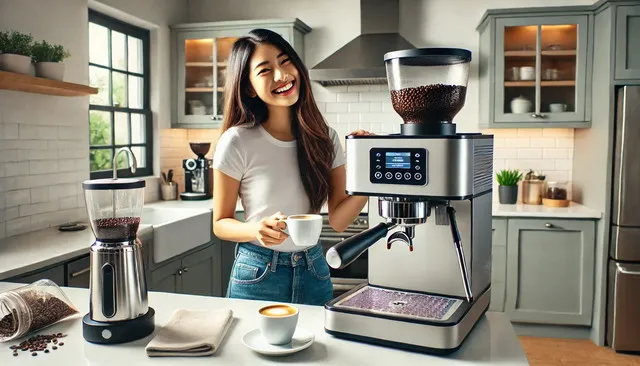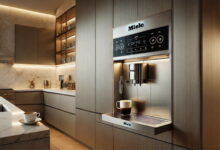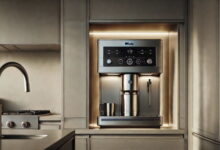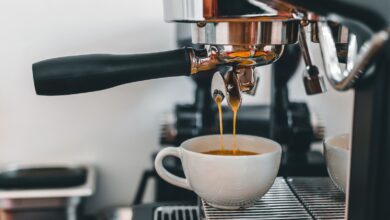Automatic Espresso Machine with Grinder: The Ultimate Guide to Brew Perfection
Automatic Espresso Machine with Grinder
Automatic espresso machines with grinders are becoming increasingly popular among coffee enthusiasts. These machines not only simplify the brewing process but also ensure that each cup of espresso is crafted with freshly ground coffee, enhancing flavor and aroma. Individuals looking for a convenient way to enjoy café-quality coffee at home will find these devices particularly appealing.
With many options available, it is essential to understand the features that distinguish each machine. Factors such as ease of use, maintenance requirements, and the quality of espresso produced can significantly influence the overall experience. Exploring the various functionalities and aesthetics can lead to a more satisfying purchase that meets personal preferences and lifestyle needs.
Understanding how to select the right automatic espresso machine involves considering both technical specifications and individual home environments. The right choice can elevate everyday coffee rituals, making them both pleasurable and efficient, while providing a great return on investment.
Key Takeaways
- Automatic espresso machines with grinders enhance convenience and quality.
- Selecting the right machine depends on personal preferences and usage.
- Understanding features and maintenance can lead to a more satisfying coffee experience.
Understanding Automatic Espresso Machines with Grinders
Automatic espresso machines with grinders are designed to streamline the coffee-making process. These machines combine grinding and brewing into one, offering convenience and consistency. Understanding their functionality and the types of grinders available is crucial for making an informed choice.
How They Work
Automatic espresso machines with built-in grinders simplify the coffee preparation process. A user loads whole coffee beans into the machine, which then automatically grinds the beans. This is typically done right before brewing, ensuring maximum freshness.
Once ground, the coffee is pressed into a puck and brewed. Many machines allow users to adjust grind size, brew strength, and milk frothing options, all at the touch of a button. Automatic models often feature programmable settings, enabling users to create a customized drink with minimal effort. This integration enhances the daily coffee ritual.
Types of Grinders in Automatic Espresso Machines
There are two main types of grinders found in automatic espresso machines: conical burr grinders and ceramic burr grinders.
- Conical Burr Grinder: This grinder uses two cone-shaped burrs to crush beans evenly, preserving flavor and aroma. It generates less heat, preventing burnt coffee, and typically offers adjustable grind sizes for specific coffee styles, from espresso to French press.
- Ceramic Burr Grinder: Ceramic grinders provide a similar function but are made from a durable ceramic material. They are praised for their sharpness and longevity. These grinders can also produce consistent grinds and do not heat up as much during operation, making them ideal for preserving coffee flavor.
Both grinder types play a significant role in the machine’s overall performance, affecting flavor extraction and end quality of the espresso.
Selecting the Right Machine for Your Needs
Choosing an automatic espresso machine with a grinder involves understanding specific requirements based on where it will be used. Factors include ease of use, space constraints, and the volume of coffee needed. Below are tailored recommendations based on different scenarios.
For Home Baristas
For home baristas, a top-rated automatic espresso machine with a grinder should emphasize versatility and quality. Machines like the Breville Barista Express or Gaggia Brera are great choices. They offer user-friendly interfaces and adjustable settings that enable customization of grind size and brew strength.
Home machines should also be compact, making them suitable for small kitchens. Features such as a built-in steam wand for milk frothing enhance the coffee-making experience. Finally, machines designed for beginners simplify the process without sacrificing beverage quality.
For Office Use
When selecting an automatic espresso machine with a grinder for office use, efficiency and ease of maintenance are key considerations. Models such as the Philips 3200 excel here, balancing functionality with straightforward operation. This machine can serve a variety of drinks, accommodating different tastes.
Space is often limited in an office, so a compact design is essential. Furthermore, the ability to brew multiple cups quickly can keep employees satisfied during busy mornings. Machines that are easy to clean and refill minimize downtime and enhance productivity.
For Commercial Use
In commercial settings, reliability and brewing capacity become paramount. An automatic espresso machine with a grinder tailored for commercial use, like the Rancilio Silvia M V6, combines durability with advanced features. These machines can handle a higher volume of coffee and deliver consistent quality under pressure.
Additionally, they should offer programmable settings to accommodate various customer preferences. Maintenance features such as self-cleaning capabilities can save time and labor costs. Investing in a robust machine ensures that it can keep up with daily demands without compromising on the quality coffee customers expect.
Features to Consider
When selecting an automatic espresso machine with a grinder, it’s essential to assess key features that affect quality, convenience, and overall user experience. Important aspects include the type of grinder, adjustable settings, water filtration, and milk frothing capabilities.
Grinder and Burr Types
The grinder is a crucial element in an automatic espresso machine. They usually come with either flat or conical burr grinders. Conical burr grinders tend to offer a more consistent grind size, which is vital for achieving rich, flavorful espresso. On the other hand, flat burr grinders can produce a uniform grind but may heat the coffee beans during the grinding process.
Some machines provide adjustable grinder settings, allowing for customization that caters to personal preferences, from fine for espresso to coarser grinds for drip coffee. A programmable automatic espresso machine with a grinder often includes these features, making it easier to select the perfect grind size for any brew method.
Adjustable Settings
Adjustable settings are essential for tailor-made coffee experiences. Many machines feature programmable options that allow users to control grind size, extraction time, and water temperature. This adaptability ensures that each cup can be brewed precisely according to individual tastes.
Look for machines offering options for single or double shots, along with customizable dosage settings. A high-quality automatic espresso machine with adjustable grinder settings often includes a user-friendly interface, making it easy for anyone to set their preferred parameters quickly.
Water Filtration and Boiler Types
Water quality plays a significant role in brewing delicious espresso. Some automatic espresso machines come equipped with built-in water filters, enhancing flavor by reducing impurities. Utilizing filtered water can improve taste, especially in areas with hard water.
Moreover, the type of boiler in the machine can affect performance. Single boilers can be efficient but may struggle with simultaneous brewing and steaming. In contrast, machines with dual boilers allow for simultaneous espresso extraction and milk steaming, providing a more efficient workflow for those who frequently prepare cappuccinos or lattes.
Milk Frothing Capabilities
For coffee enthusiasts who enjoy milk-based drinks, milk frothing capabilities are crucial. Many automatic espresso machines now feature built-in milk frothers or steam wands. A machine with a steam wand allows for manual control, enabling users to create microfoam for lattes and cappuccinos.
Alternatively, some machines provide an automatic milk frothing system, where users can simply select their desired milk texture and temperature. The best fully automatic espresso machines with a grinder and steamer simplify the process, making it easier to produce café-quality beverages at home.
The Economics of Automatic Espresso Machines
Understanding the cost implications of automatic espresso machines with grinders is crucial for potential buyers. This includes examining price points, value for money, and long-term expenses.
Price Comparison
When shopping for an automatic espresso machine with a grinder, prices can vary widely. Affordable options start around $200, making them accessible for many consumers.
For those willing to invest more, the best automatic espresso machines under $1000 typically offer superior features, such as advanced grinding capabilities and customizable settings.
High-end models often exceed $1000 and are aimed at enthusiasts who demand precision. Features like integrated milk frothers and dual boilers are common in these machines, enhancing their coffee-making capabilities. This investment often leads to better taste and more durable components.
Cost-Effectiveness and Energy Efficiency
Cost-effectiveness is vital in assessing an automatic espresso machine. Buyers should consider how much they spend on coffee daily. Investing in a machine that allows for making café-quality drinks at home can save significant amounts over time.
Energy-efficient machines are increasingly available, designed to consume less power while delivering excellent performance. This might include programmable settings that turn off the machine after use or energy-saving modes. These features not only help lower utility bills but also contribute to a sustainable lifestyle.
Maintenance and Longevity
Automatic espresso machines with grinders can require varying levels of maintenance. A model that prioritizes easy maintenance will appeal to many users. Regular cleaning and occasional descaling are necessary to ensure longevity and optimal performance.
Some machines also come with self-cleaning features, simplifying upkeep significantly. Choosing a high-quality machine can mean fewer repairs and a longer lifespan, making it a better financial decision in the long run. Regular maintenance practices can keep operational costs low while ensuring the machine remains in good working order.
Sound and Space Considerations
When selecting an automatic espresso machine with a grinder, two critical factors are sound levels during operation and the machine’s physical dimensions. The right balance can enhance the brewing experience, especially in small living spaces.
Quiet Operation
A quiet automatic espresso machine with a grinder is ideal for those who appreciate a peaceful environment. Noise levels during grinding and brewing can range widely between models. Some manufacturers design machines to minimize sound, featuring insulated housing or quieter grinding mechanisms.
For example, look for machines with conical burr grinders, which often operate more silently than traditional blade grinders. Users will appreciate the reduced noise, particularly during early mornings or late-night coffee sessions. Additionally, machines that utilize programmable settings can allow brewing at times when disruption is minimal, catering to both lifestyle and noise preferences.
Size and Footprint
Compact automatic espresso machines with grinders are essential for small spaces. These machines vary in dimensions, with some designed expressly for tight kitchen environments. Users should consider both height and width, as some models extend vertically, fitting under cabinets, while others may have bulkier designs.
While evaluating size, it’s also important to consider additional features like water reservoirs and bean hoppers. A machine with a smaller footprint might sacrifice capacity, so balancing space and functionality is key. Potential buyers should measure counter space to ensure a proper fit, allowing the machine to perform efficiently without compromising kitchen aesthetics.
Ease of Use and Maintenance
An automatic espresso machine with a grinder simplifies the coffee-making process, providing both convenience and quality. Key aspects like cleaning processes and self-care features are essential for maintaining optimal performance and longevity.
Cleaning Processes
Automatic espresso machines with grinders often include intuitive cleaning mechanisms. Many models feature removable brewing units, making it easy to access and clean the components that come into contact with coffee.
Users should pay attention to the following components:
- Brew Group: Usually removable for easy rinsing.
- Drip Tray: Should be emptied and cleaned regularly to prevent overflow.
- Coffee Grounds Container: Should be emptied frequently to keep the machine running smoothly.
Some machines also have a self-cleaning cycle, requiring minimal user intervention. It’s advisable to follow the manufacturer’s instructions for cleaning to ensure the machine maintains its performance over time.
Descale and Self-Care Features
Descaling is crucial for maintaining the functionality of an espresso machine. Many automatic machines come equipped with self-descaling features, alerting users when it’s time to descale. This process prevents the build-up of minerals, ensuring a consistent extraction and prolonging the life of the machine.
- Descaling Alerts: Prompt users to take action.
- Automatic Programs: Simplify the cleansing process.
Regular maintenance routines are essential. Selecting models that include automatic self-care options can greatly reduce the hassle involved. Users should choose a machine that offers these features to enjoy a hassle-free coffee experience.
Advanced Functionalities
Automatic espresso machines with grinders offer several advanced features that elevate the coffee-making experience. These functionalities enhance user convenience and allow for personalized brewing.
Programmable Brewing Options
Programmable brewing options are a standout feature of modern espresso machines. Users can set specific brew times, adjusting the strength and volume of their coffee. These machines often come with preset options for popular beverages like lattes and cappuccinos, which simplifies the process for those who enjoy these drinks regularly.
Some models enable users to create and save custom recipes, tailoring the brewing parameters to their preferences. For example, a programmable automatic espresso machine with a grinder can allow adjustments to brewing temperature and extraction time. This capability is beneficial for craft coffee enthusiasts seeking the perfect shot every time.
Customizable Profiles
Customizable profiles provide additional versatility in an automatic espresso machine with customizable settings. Many machines allow multiple users to create individual profiles, saving personal preferences such as grind size, water temperature, and coffee strength.
This feature is ideal for households with varying coffee tastes. For instance, one user might prefer a strong espresso while another opts for a milder brew. It ensures that everyone can enjoy their ideal cup without constant adjustments. Additionally, some models can be programmed via a smartphone app, making it easier to manage profiles and settings remotely.
Additional Beverages
The ability to make additional beverages is an advantage for those who enjoy variety. Many advanced machines allow users to prepare not only espresso but also other drinks such as iced coffee, macchiatos, and flat whites.
Some top-rated machines excel at creating lattes and cappuccinos due to their built-in milk frothers. This feature enhances the coffee-making experience and caters to diverse preferences. A well-rounded automatic espresso machine with grinder for making iced coffee can provide refreshing seasonal beverages, appealing to users seeking new taste experiences.
By integrating these advanced functionalities, these machines appeal to both casual users and serious coffee aficionados, effectively broadening the coffee culture at home.
Quality of Espresso
The quality of espresso produced by an automatic espresso machine with a grinder is determined primarily by two factors: the presence of rich crema and the precision of pressure and temperature controls. Both aspects play a critical role in achieving the desired flavor and texture in every shot.
Crema and Flavor
Crema is the golden layer of foam that sits atop a perfectly brewed espresso. A high-quality espresso machine should extract enough oil and solubles to produce a rich, thick crema. Machines that are well-designed contribute to better extraction, resulting in an espresso that has a fuller flavor profile.
The best automatic espresso machines with grinders, like the Breville Barista Touch, excel in creating this desirable crema. Proper grind size and consistency are also crucial. A burr grinder integrated into the machine ensures uniform grinding, enhancing the espresso’s flavor.
In addition, the fresher the coffee beans, the richer the crema will be. Machines equipped with features allowing custom grind settings enable users to fine-tune the extraction process for the best results.
Pressure and Temperature Controls
Pressure and temperature are critical for optimal espresso extraction. The ideal pressure for espresso brewing is around 9 bars. Some automatic machines come with a built-in pressure gauge, allowing users to monitor and adjust this parameter easily.
Temperature consistency is equally important. A brewing temperature between 190°F and 205°F ensures that the coffee is extracted at its best. Machines with PID temperature control provide greater stability, preventing fluctuations that can affect flavor.
High-quality automatic espresso machines, like the Gaggia Brera, offer excellent pressure and temperature controls, ensuring consistent espresso shots. This accuracy is essential for producing well-balanced shots that highlight the nuanced flavors of the coffee.
Aesthetic and Build Quality
The aesthetic appeal and build quality of an automatic espresso machine with grinder significantly influence consumer choice. A stylish design paired with durable materials enhances the functionality and longevity, making it a worthwhile investment.
Material and Design
Many automatic espresso machines feature a stainless steel body that not only provides a sleek, modern look but also ensures resistance to rust and corrosion. The use of stainless steel contributes to a professional appearance, often seen in coffee shops. In addition, digital displays are commonly integrated, offering user-friendly interfaces for easy control of settings like grind size and brew strength.
A well-designed machine often includes thoughtfully placed buttons and knobs that promote both aesthetics and functionality. Color options and modern finishes can also enhance the visual appeal, allowing consumers to choose a model that matches their kitchen décor.
Durability Factors
When considering durability, the quality of materials is paramount. Stainless steel bodies withstand wear and tear better than plastic counterparts. Features like reinforced knobs and high-grade internal components can further enhance longevity.
Regular maintenance is easier with machines that have removable parts, promoting long-term use. Some models incorporate advanced heating systems and built-in grinders designed for heavy usage. Ultimately, a robust construction not only ensures a longer lifespan but also provides a consistent performance for coffee enthusiasts.
Accessories and Additional Features
When considering an automatic espresso machine with a grinder, various accessories and features enhance the brewing experience. These elements, such as water reservoirs, cup warmers, and integrated scales, play crucial roles in convenience and coffee quality.
Water Reservoir and Filtration
A large water reservoir is essential for convenience, allowing for multiple servings without frequent refills. Some models offer filtration systems that improve water quality, resulting in better-tasting espresso.
Machines designed for home baristas often feature reservoirs capable of holding up to 2 liters or more. Improved filtration reduces minerals like calcium, which can affect the taste.
Regular cleaning is important. Many machines have detachable reservoirs for easy access, ensuring maintenance is straightforward. User preferences vary, so finding a machine with a suitable reservoir size and filtration system is key.
Cup Warmer and Storage
Cup warmers are a valuable addition to an automatic espresso machine with a grinder. They keep cups at an ideal temperature, enhancing the espresso’s aromatic properties. This is particularly beneficial for those who enjoy multiple shots.
Some machines come equipped with dedicated storage for cups, providing a neat solution to keep cups readily available. The surface of the warmer often can preheat multiple cups, maintaining consistent temperature before serving.
For users who prioritize convenience, machines with built-in cup warmers are ideal. They eliminate the need for separate appliances and integrate seamlessly into the coffee-making process.
Integrated Scales and Tampers
For precision brewing, integrated scales and tampers are significant features. These tools help measure the coffee grounds accurately, ensuring consistent flavor. Many machines include built-in tampers, providing balanced pressure during the brewing process.
A machine that features automatic dosing and tamping simplifies the preparation process, making it suitable for beginners and experts alike. This provides a way to achieve professional-level results without extensive training.
Models that incorporate scales allow for a customizable approach to brewing. Users can adjust amounts based on preferences, giving them control over their coffee’s strength and flavor.
Frequently Asked Questions
This section addresses common inquiries regarding automatic espresso machines with grinders. The focus will be on maintenance, capacity for commercial use, essential features, pricing, quality comparisons, and performance of smaller machines.
How do I maintain and clean an automatic espresso machine with grinder?
Regular maintenance is vital for optimal performance. Users should clean the brew group and water reservoir frequently. Descaling the machine every few months helps prevent mineral buildup, while regularly checking and cleaning the grinder ensures consistency in grind size.
Can commercial automatic espresso machines with grinders handle high volumes of coffee making?
Yes, commercial automatic espresso machines are designed for high volume. They often feature robust build quality and faster brewing times. Additionally, many come with advanced grinders that can handle continuous use without compromising on quality.
What are the essential features to look for in a fully automatic espresso machine with a grinder for the best quality espresso?
Key features include a high-quality burr grinder, programmable settings, and a reliable heating system. An adjustable brew temperature and pressure control also contribute to better extraction and flavor. A good milk frothing system is essential for those who enjoy lattes and cappuccinos.
What is the price range for a high-end super automatic espresso machine with a grinder?
The price range for high-end models typically falls between $1,500 and $3,000. Some premium machines can exceed $3,000 depending on features and brand reputation. Buyers should consider the longevity and features offered when evaluating the price.
How does the espresso quality from automatic machines with grinders compare to manual espresso-making methods?
Espresso from automatic machines can match that of manual methods when using quality ingredients. The consistency in grind size and extraction can actually enhance flavor. However, skilled baristas may still prefer manual methods for greater control over the brewing process.
Can small automatic espresso machines with grinders produce the same quality of espresso as larger machines?
Small automatic espresso machines can produce high-quality espresso but may have some limitations. Factors like water pressure and heater performance can affect the extraction. Nevertheless, many compact models are designed to deliver impressive results in a smaller footprint.








